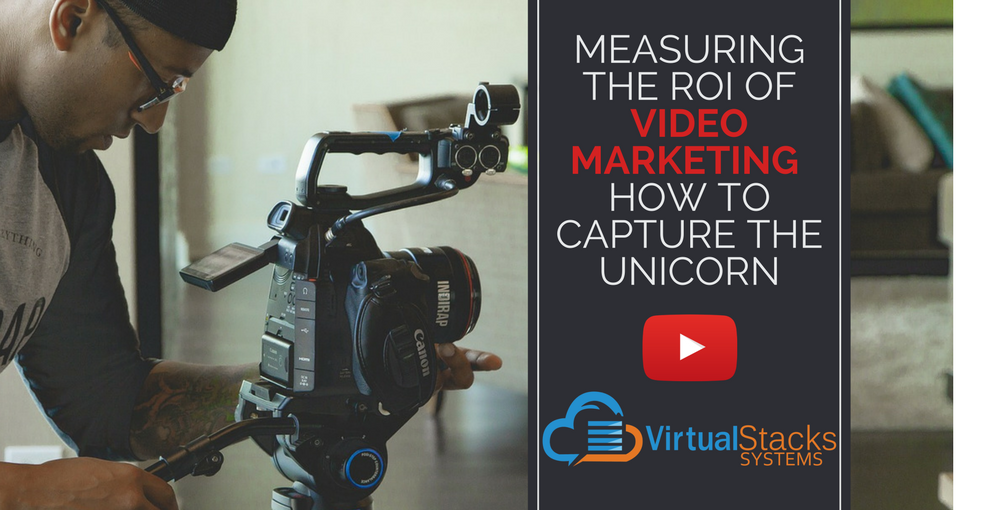
06 Apr Measuring the ROI of Video Marketing – How to Capture the Unicorn
Video marketing has matured beyond the “next big thing” or “shiny new toy” stage. Digital consumption trends have shifted heavily toward video over the past six years. That is, people would rather watch video than read. However, grabbing eyeballs for cat videos is different from making sure your marketing video is not only being seen by members of your target market, but that its viewers are taking the desired action to make your investment worthwhile. For those wondering if it’s possible to measure the ROI of video marketing, the answer is yes. In fact, 51% of marketing professionals worldwide name video as the type of content with the best ROI.
Achieving measurable results with video marketing takes planning and some amount of work – it isn’t as easy as posting to YouTube and waiting for views. And for those expecting your video to “go viral,” even if lightning strikes, it doesn’t mean that everyone who watches will be your customer. Approaching video in the same way as other components of your marketing campaign can help your business reach its goals – whether to draw in qualified leads, increase sales, etc. Here are the main steps.
Establish a goal – It may seem obvious, but first determine what business objective the video content addresses.
Video marketing goals typically fall into one of the following categories:
• Brand awareness
• Engagement
• Lead generation
• Lead nurturing
• Increasing sales
• Customer service
• Education (product demonstration videos, for example)
Determine what specific action you want the viewer to take after watching the video. Keep in mind that a video is one piece of your larger conversion funnel, which should also consist of social media, blogging, email marketing, etc. Tracking ROI is easier when you are more accurately able to identify each video’s place in the conversion funnel and its specific objective.
Make sure your content is designed to accomplish its goal – A video intended to generate leads should link to a demo request landing page instead of standing alone. Again, this goes back to identifying a video’s role in the conversion funnel and making sure all of the components work together. Creating a dedicated landing page for your video rather than relying on YouTube as its sole host can make a big difference, because 60% of visitors will watch a video before reading text on the web page. When visitors click on the link, they’ll be drawn to engage further with social calls-to-action, promotions of your blog, and other related materials on the page.
Establish your KPIs – Having established your goal, you need to link them to key performance indicators. KPI benchmarks are measurable and closely related to the underlying goal. KPIs provide metrics that tell you how well (or below par) the video performs.
Best KPIs for Measuring Video Marketing
• Awareness: Determined by the number of views and/or the percentage of viewers who watched the explainer video all the way through, etc.
• Engagement: Includes the percentage of completed video plays, average length of viewing, referral traffic to your website, shares on social media and comments.
• Lead generation: The number of sign-ups to a mailing list or the number of downloads of a report/booklet/whitepaper, etc., after viewing.
• Lead nurturing: The number of requests for an initial consultation, product demo or free trial product/service.
• Sales: The amount of revenue attributable to video views.
However, be aware that many of these KPIs depend upon a basis of reference. You can’t measure the impact of video on the effectiveness of a landing page without recording a baseline of how that page performs without video. Or be able to track video’s effect on purchase behavior if your content analytics aren’t integrated with a CRM (customer relation management) system – such as our own eZnetCRM platform for integrated business operations.
Establish the right frame of reference – Measurement is even more valuable when put into the context of a frame of reference that helps guide future decisions.
The basic frameworks are absolute, relative and attribution modeling ROI.
Absolute ROI – looks at what result spending X-amount of money on the video creates. If it costs $500 to produce and nets 80 brochure downloads (your key benchmark), determining the amount each lead costs tells if the video was a profitable investment.
Relative ROI – compares how well a video performed with your other marketing strategies. If spending the same amount of money on another strategy, like PPC text ads, which produced the better result?
Attribution Modeling ROI – measures the impact of each marketing component – such as display, social, print, etc. – on the overall results in a comprehensive manner.
The Take-home message – If your business is just looking into the marketing value of video, or is currently exploring it but not quite satisfied with the results, getting the right focus will justify your long-term investment. Our video production services at Virtual Stacks Systems produce a wide variety of marketing videos – and we provide social media marketing services for a comprehensive solution. Contact us to learn more.
